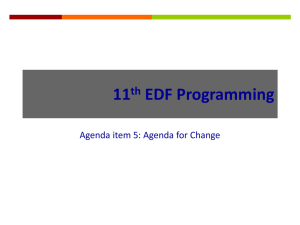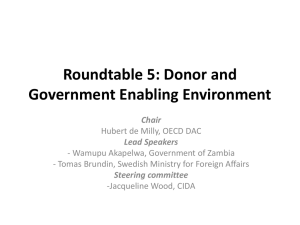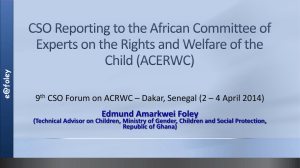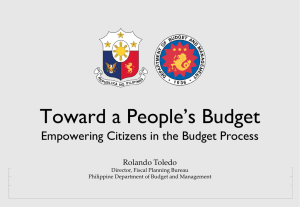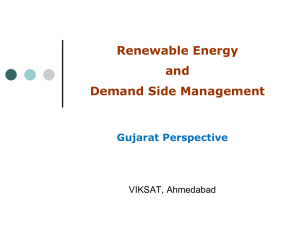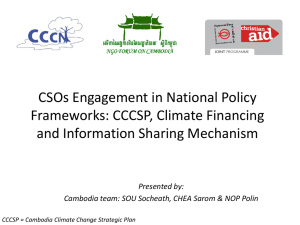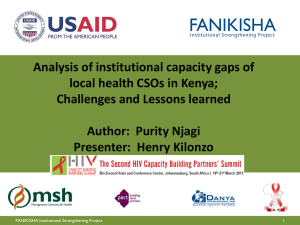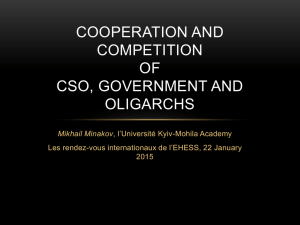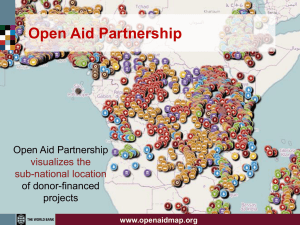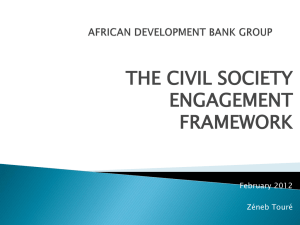III. Key moment(s) at EU level
advertisement
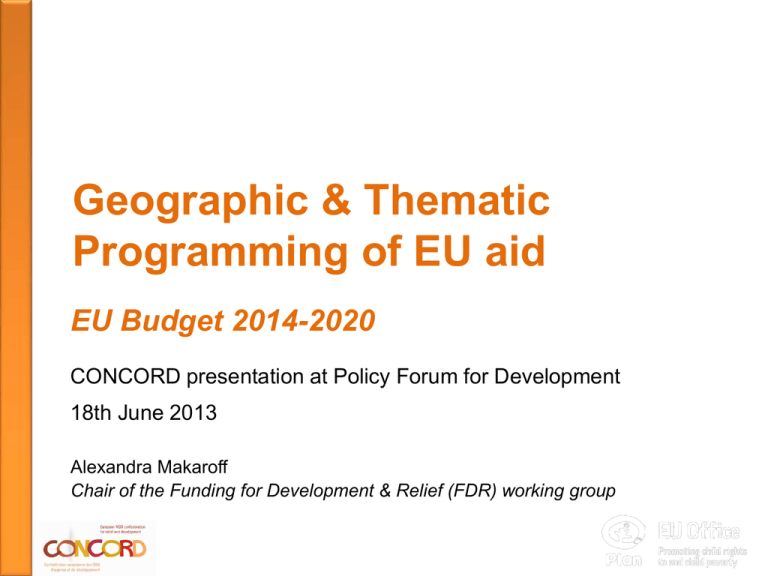
Geographic & Thematic Programming of EU aid EU Budget 2014-2020 CONCORD presentation at Policy Forum for Development 18th June 2013 Alexandra Makaroff Chair of the Funding for Development & Relief (FDR) working group Euro-glossary of terms • • • • Multi-annual Financial Framework: The official term for the 7-year financial perspective 2014-2020. Known as ‘MFF’. Heading 4: 5 headings in MFF, Heading 4 ‘Global Europe’ covers external actions Development Cooperation Instrument (DCI): ODA for developing countries within Heading 4 (Asia, Central Asia, Latin America) The European Development Fund (EDF), outside the EU budget, for the ACP countries MFF will shape the future of EU development assistance! Towards an EU Budget 2014-2020: a long process 2013: 06/2011: EC proposal released 12/2011: External aid package released 2012: negotiations on the volume and the instruments (geo and sectorial priorities) May: EDF approved July (Sept?): reach final agreement on the overall budget Jan-Dec: programming of geo. and thematic instruments Geographic Programming Which geographic programmes? Development Cooperation Instrument (DCI) • Proposed funding: € 14 billion • 19 countries in Asia and Latin America not to benefit from bilateral aid anymore • Pan African programme to support the Joint Africa-EU Strategy European Neighbourhood Instrument (ENI) European Development Fund (EDF) • Proposed funding: € 34.2 billion • From 6 to 7 years programme • Some countries will receive less funds that under 10th EDF • Intra ACP share remains same • Proposed funding: € 18.2 billion • 16 countries covered • Principle of « more for more » and mutual accountability • From 29 thematic priorities to 6 objectives • Bilateral, multi-country and cross border cooperation programmes • Alignement to National Development Plans • 3 priority sectors for EU intervention • Multi-annual Indicative Programmes (MIPs) • Common Implementing Rules (CIR) Geographic Programming process: phases and timeline MIPs EU priority sectors Phase 1 May …. 2012 Dec Phase 2 Jan Feb. March April May June July Aug. Sept. 2013 01/07: Assessement of national development plan End Dec: EU 3 priority sectors defined June 2013: Start drafting EDF Multiannual Indicative Programmes (MIPs) Start drafting DCI MIPs delayed End 2013: MIPs finalised (?) Phase 1: Priority sectors DCI/EDF Programming instructions sent to all EU Delegations end of May 2012 Instructions included: Context analysis and guiding principles (Agenda for Change): 1. 2. Human Rights, democracy and good governance Inclusive and sustainable growth: a) b) c) d) Climate change and environment Health & education Sustainable agriculture, fisheries and food security Sustainable energy Summary of phases of programming process Various Annexes: Guiding principles for sector concentration and choice of sectors (Annex II) Template for analysis of NDP (Annex III) Template for CSO (Annex IV) Template for Multi-annual Indicative Programme (MIP) – (Annex V) Phase 2: Multi-annual Indicative Programme • Central document of programming process • Structure of the MIP: Financial allocation to each sector overall and specific objectives for each sector Main expected results for each specific objective Main indicators for each result • Cross-cutting issues also to be taken into account (HRs, CRs, gender) • Will define implementation modalities (Budget support, calls for proposals, ...) • Country led process • Delays in phase 2: DCI and EDF process split. • EDF instructions sent early June to EU Delegations in ACP countries • 31st October 2013: deadline for EUDs to send their draft MIP to Bxl Why is it important for CSOs to get involved? 1. This process happens once every 7 years! 2. EU Delegations and national government to decide how to put in practice EU policy guidelines 3. EU Delegations to negotiate with partner country amounts and priority sectors for development 4. EU Delegations has obligation to organise consultation with CSOs 5. CSOs to play important influencial role: which sectors, which instruments, how much, ... Unique opportunity! Final decisions @ national level Need to ensure they take place! Opportunity to raise your profile How to get involved during phase 2? • What is the exact deadline for EUD to produce the MIP? Request information • How will they do it? on the process • How do they plan to consult CSOs in the process? Coordinate with partners Liaise with partner government • To ensure local CSOs are aware of opportunity • Organise meeting with CSO networks to prepare common actions and joint recommendations • Ministry of International Cooperation (leading negotiations) • Other Ministries (Health, Education, …) to influence lead Ministry in negotiations Thematic Programming Which thematic programmes? CSO-LA instrument DCI • Regions: all third countries • Proposed budget: € 2 billion • Complementarity to geographic funding BUT will not subsitute graduated countries Global Public Good & Challenges EIDHR DCI • Regions: all third countries • Proposed budget:€ 6.3 billion • Scope: human development, environment, energy, food security & agriculture, migration • EC will not launch a CfP per sector anymore • EC wants policy alliances with partner countries to make sustainable changes in a holistic manner • Regions: all third countries • Proposed budget: € 1.6 billion • Facility for human rights in situation of crisis (Emergency situations) • Early warning (new), temporary relocation & legal support • Networking, coordination, capacity building & support to national HR institutes Process and timeline Multiannual Indicative Programmes (MIPs) will also be drafted for the thematic instruments o o o CSO-LA: preliminary document presented in Oct 2012 at Policy Forum on Development EIDHR: preliminary document presented early 2013 GPGC: Brief presentation during October PFD Timeline: Drafting of the MIPs in progress Consultations with CSOs expected, with preliminary documents to comment on. What has CONCORD done? nkn Overall negotiations - Advocacy, awareness raising and capacity building on overall MFF process/Heading 4 + DCI/EDF regulations Engaged on the content of DCI and EDF instruments Many position papers and joint work with National CSOs Programming exercise - In close coordination with CONCORD working groups and other networks, at Brussels and field levels. Tools developed to support CSOs: Template letter to the attention of EU Delegations on importance of consultation with CSOs, briefing notes on phase 1 and 2 of geo. programming Inclusive drafting process with CONCORD members of positions on CSO-LA and GPGC programmes Webinar organised for CONCORD members Mapping of CSOs consultations at EUD level Survey to assess quality of consultation (launched on 15/05) – see map CONCORD Survey on CSO consultations in Geographic Programming of EU aid – phase 1 Responses received after 2 weeks: Some preliminary results: In 72% of EDF/DCI countries, CSO consultations were organised. However, the quality of these consultations varies significantly. Main challenges: e.g. little preparatory information, background docs shared shortly before meeting, only online submissions allowed, informing instead of consulting, only few selected invitees, no follow-up, etc. How can each actor ensure SD principles are upheld in the programming nkn process? EC / EU Delegations - Include a clear recommendation/demand to consult CSOs in all phases of the programming exercise (geo and thematic) Organise genuine CSO consultations, which include: o o o Before: background docs + proper info about process preparation time + During: type of consultation, list of invitees After: follow-up process + taking CSO views into account Need transparent mechanisms for CSO involvement Consultations must be structured, qualitative and participatory! CSOs - Inform and mobilize CSOs in EU and in partner countries about process and how to get involved - both for geographic and thematic programming Watchdog role: monitor the quality of consultations and dialogue process Local CSO networks to ensure feedback mechanisms in place for its members EU Member States: - Engage with national CSOs on 2014-2020 strategies and AAPs
